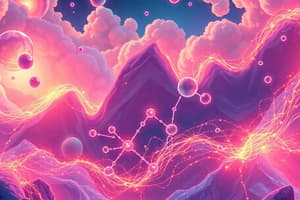Podcast
Questions and Answers
¿Qué es la cinética química?
¿Qué es la cinética química?
La cinética química se ocupa del estudio de las velocidades a las que las reacciones proceden.
¿Qué factores afectan a las velocidades de reacción?
¿Qué factores afectan a las velocidades de reacción?
La temperatura, la concentración de los reactivos y otros factores pueden afectar las velocidades de reacción.
¿Qué es la ley de velocidad en una reacción química?
¿Qué es la ley de velocidad en una reacción química?
La ley de velocidad es una ecuación empírica que relaciona la velocidad de reacción con las concentraciones de los reactivos.
¿Cómo se define la 'velocidad de reacción' en una reacción química?
¿Cómo se define la 'velocidad de reacción' en una reacción química?
¿Qué es el equilibrio químico?
¿Qué es el equilibrio químico?
¿Qué es la constante de equilibrio (K) y cómo se calcula?
¿Qué es la constante de equilibrio (K) y cómo se calcula?
¿Qué establece el principio de Le Chatelier?
¿Qué establece el principio de Le Chatelier?
¿Cuál es la ecuación de Arrhenius y qué representa cada término?
¿Cuál es la ecuación de Arrhenius y qué representa cada término?
¿En qué consisten las reacciones reversibles?
¿En qué consisten las reacciones reversibles?
¿Por qué son importantes la cinética química y el equilibrio en la vida real?
¿Por qué son importantes la cinética química y el equilibrio en la vida real?
Flashcards are hidden until you start studying
Study Notes
Chemical Kinetics and Equilibrium: Focus on Reaction Rates and Velocidad de Reacción
Chemical kinetics and equilibrium are two central concepts in chemistry, providing insights into the rates of chemical processes and their equilibrium states. This article will explore the key ideas related to reaction rates and the Spanish term for reaction rate, "velocidad de reacción," particularly focusing on reversible reactions and their equilibrium constants.
Reaction Rates
Chemical kinetics deals with the study of reaction rates, which are the speeds at which reactions proceed. Reaction rates depend on the temperature, concentration of reactants, and other factors. The rate law, an empirical equation that relates the reaction rate to the concentrations of reactants, is crucial in understanding chemical kinetics.
Velocidad de Reacción
The reaction rate, or velocidad de reacción, is the number of molecules produced or consumed per unit time in a chemical reaction. The rate of a reaction can be described in terms of its rate law, which shows the dependence of the reaction rate on the concentrations of reactants.
Equilibrium
Chemical equilibrium is the state in which the rates of the forward and reverse reactions are equal. When a system is at equilibrium, the concentrations of reactants and products remain constant over time, determined by thermodynamics and the equilibrium constant.
Equilibrium Constants and Reaction Quotients
The equilibrium constant (K) is a ratio of the concentrations of products raised to their stoichiometric coefficients, divided by the concentrations of reactants raised to their stoichiometric coefficients. The reaction quotient (Q) is a similar expression that relates the concentrations of reactants and products at any given time during the reaction.
Le Chatelier's Principle
Le Chatelier's principle states that if a system at equilibrium is subjected to a change in concentration, temperature, or pressure, the system will adjust its equilibrium position to counteract the change. The principle is useful for predicting how a system will respond to changes in its conditions.
Arrhenius Equation
The Arrhenius equation, an empirical relationship, describes the temperature dependence of reaction rates. The equation has the form of k = Ae^(-Ea/RT), where k is the rate constant, A is the pre-exponential factor, Ea is the activation energy, R is the gas constant, and T is the temperature in Kelvin.
Reversible Reactions
In reversible reactions, the forward and reverse reactions proceed at the same rate, and the system is at equilibrium when the reaction quotient (Q) equals the equilibrium constant (K). The equilibrium position can be affected by changes in temperature, pressure, and other factors.
Application of Chemical Kinetics and Equilibrium in Real Life
Chemical kinetics and equilibrium are relevant to various fields, such as biochemistry, environmental science, and industrial chemistry. Understanding these concepts helps predict reaction outcomes, optimize chemical processes, and design new materials or products.
In summary, chemical kinetics and equilibrium are interconnected topics that provide a comprehensive understanding of the rates of chemical reactions and their equilibrium states. By exploring these ideas, we can gain insights into the behavior of chemical systems and their potential applications in various fields.
Studying That Suits You
Use AI to generate personalized quizzes and flashcards to suit your learning preferences.



